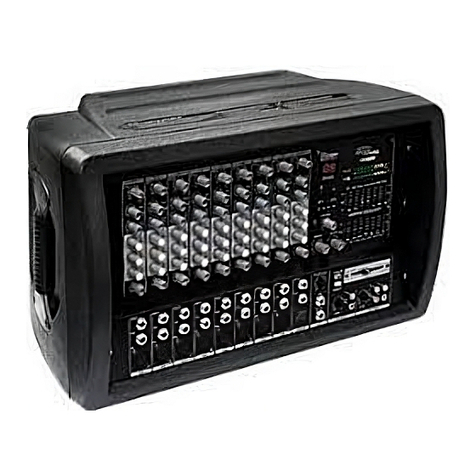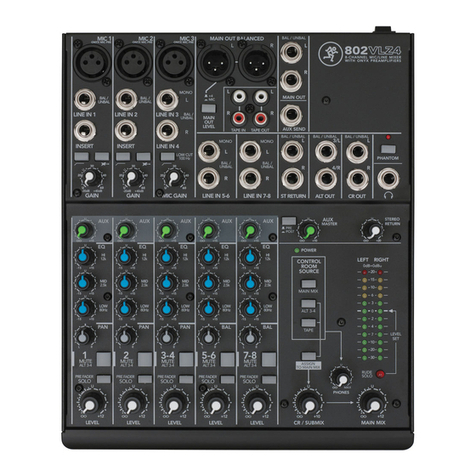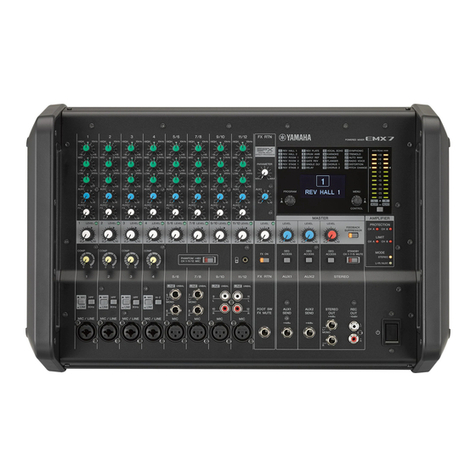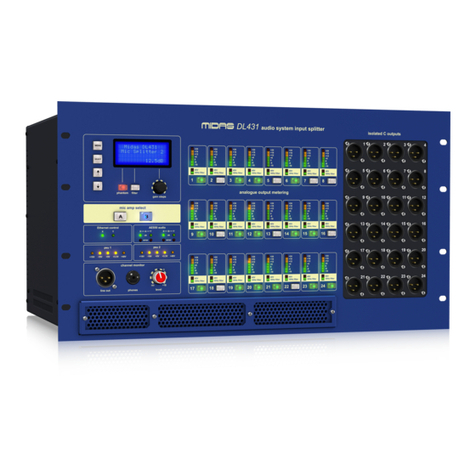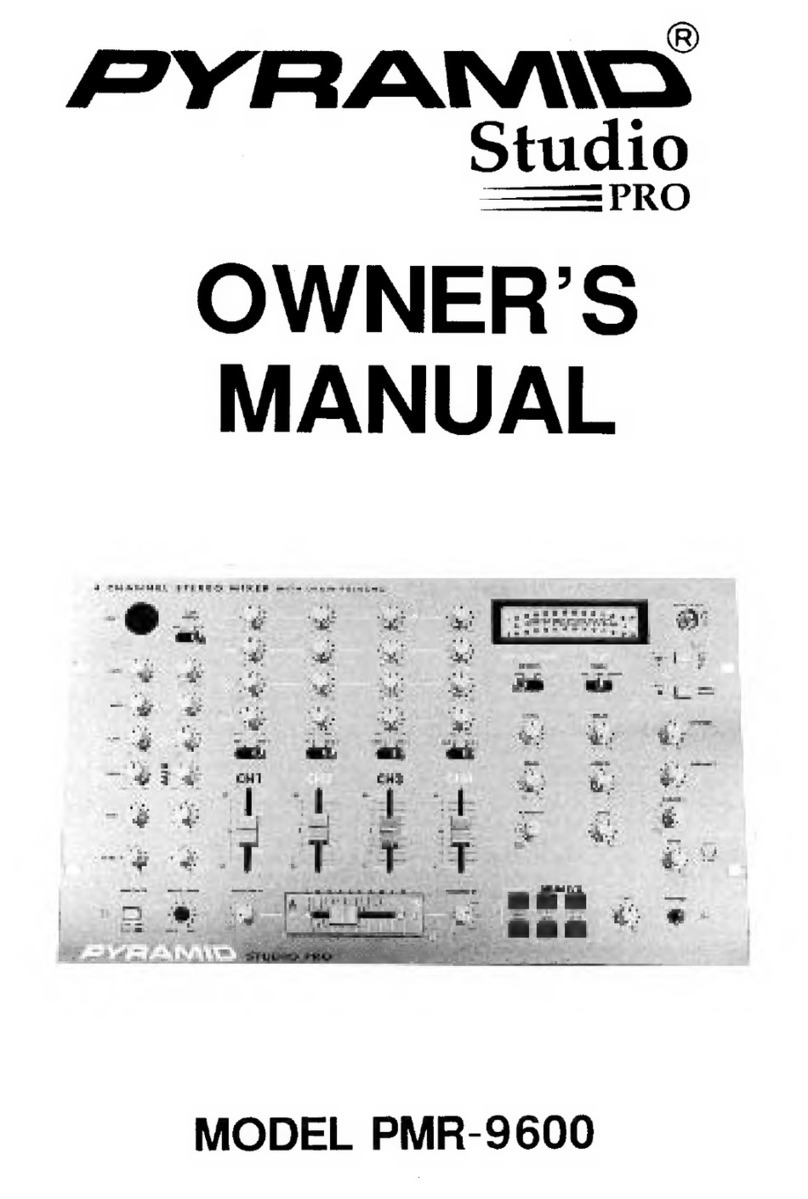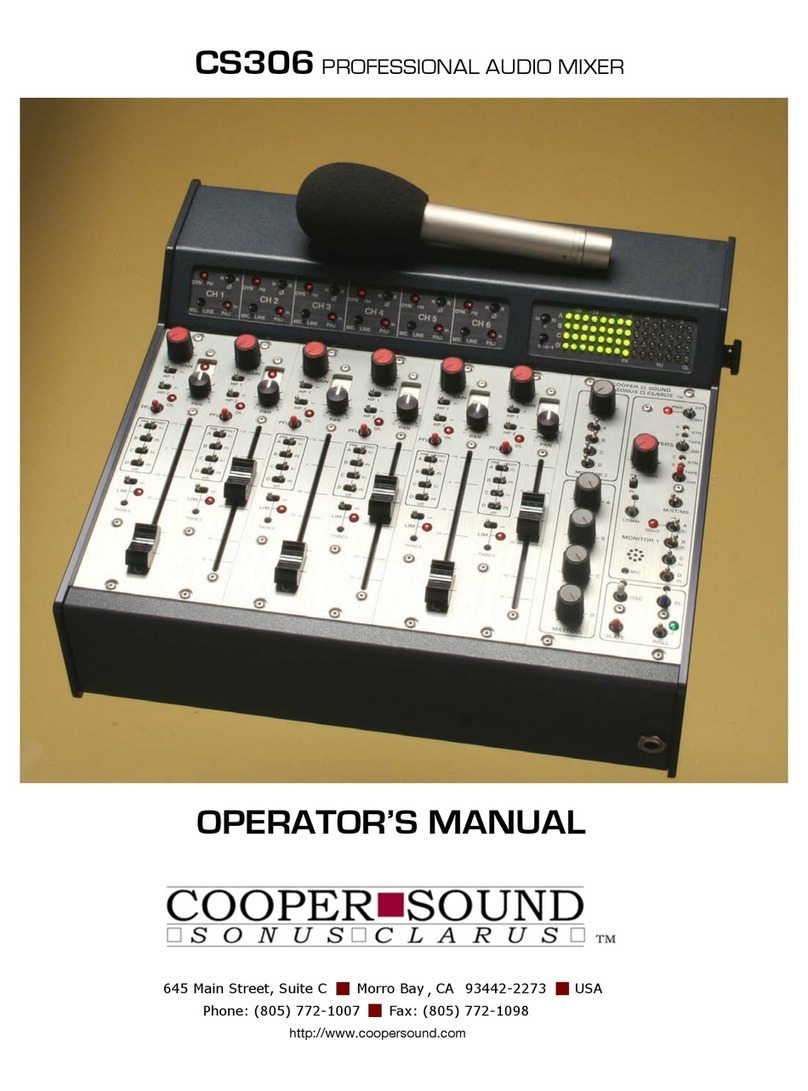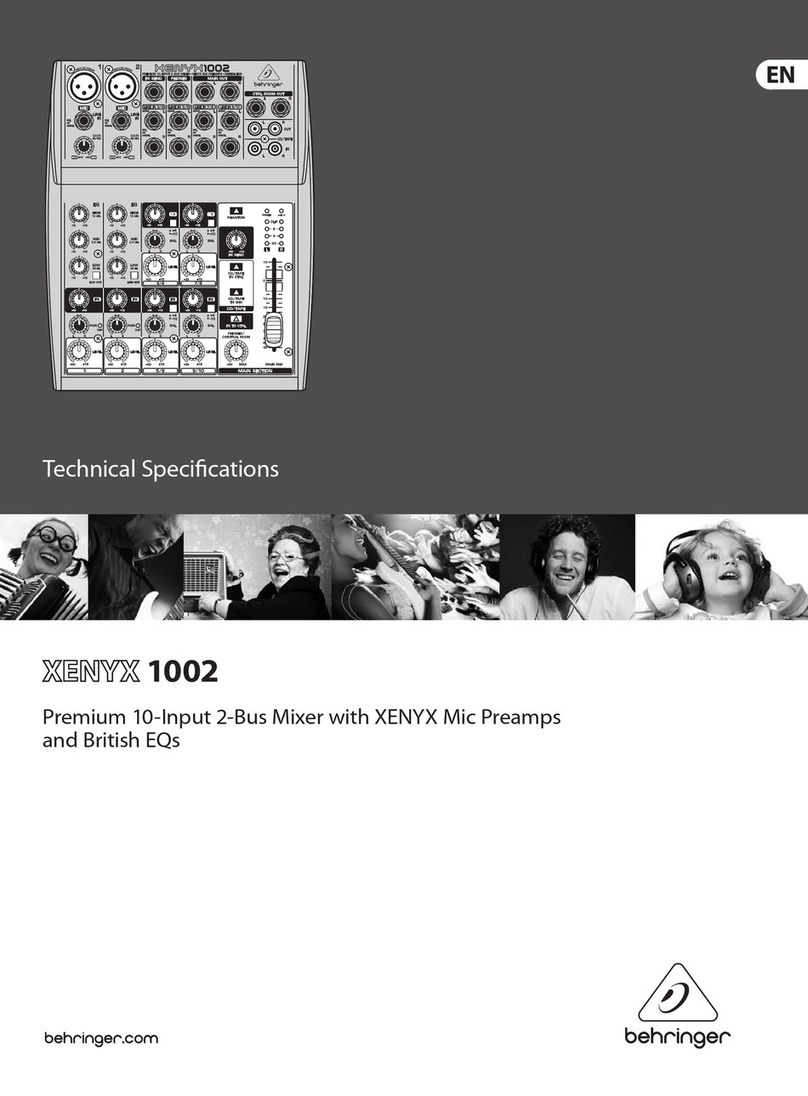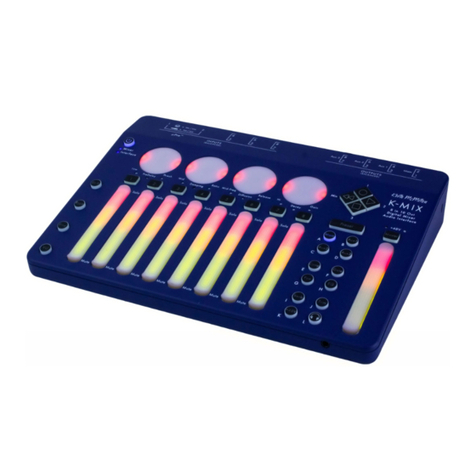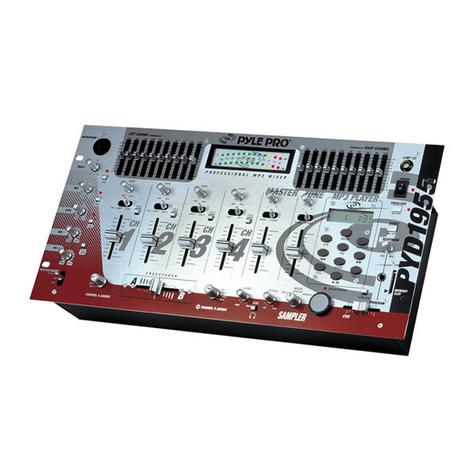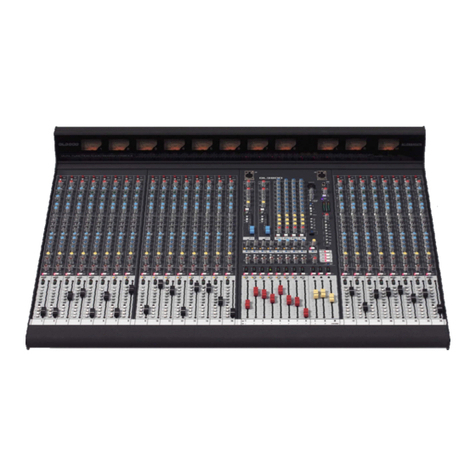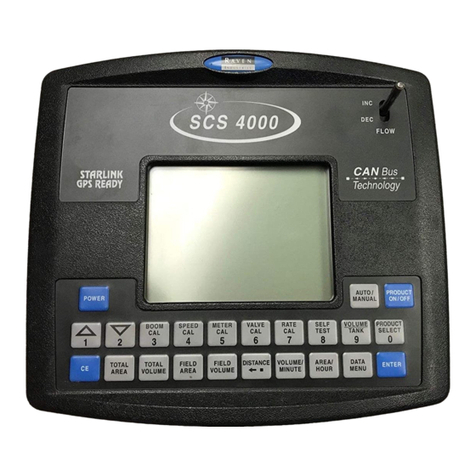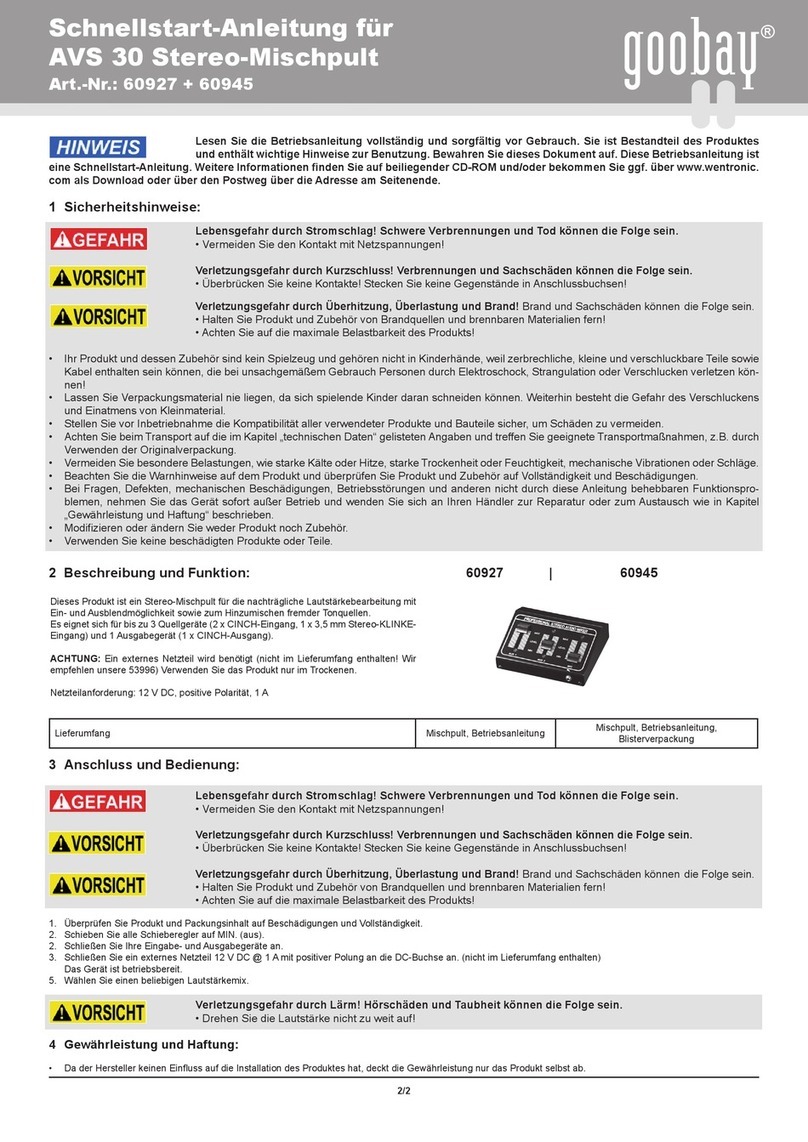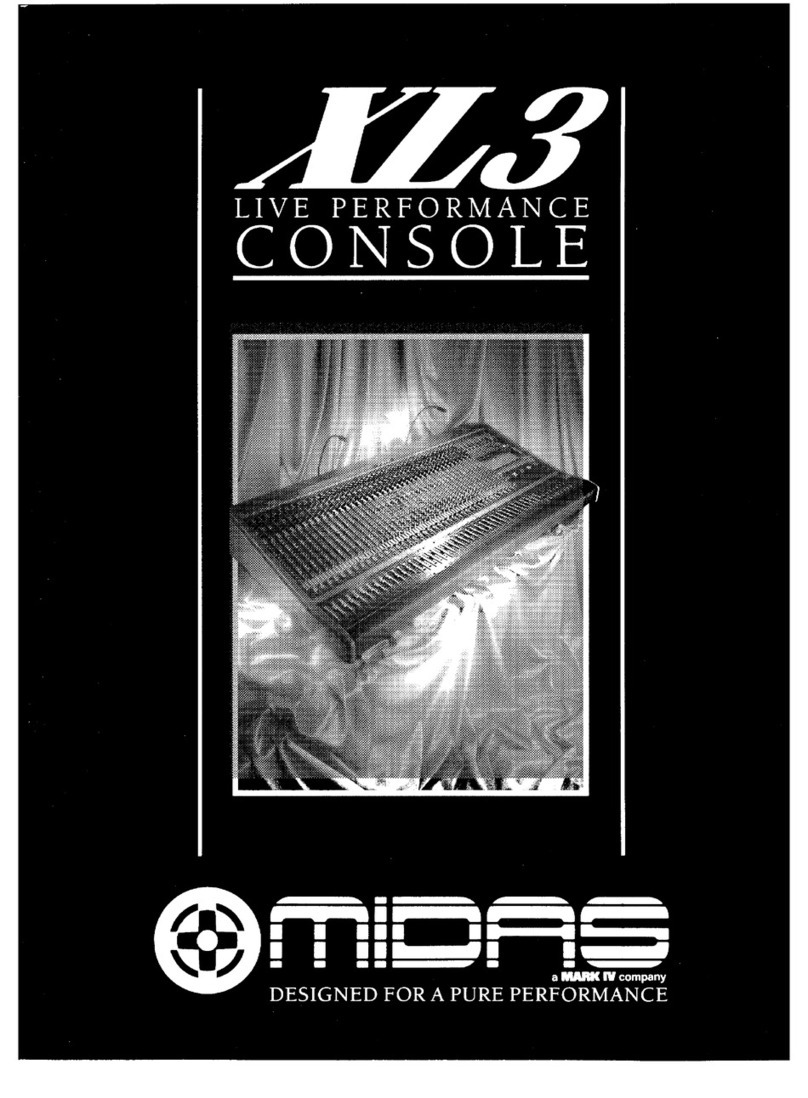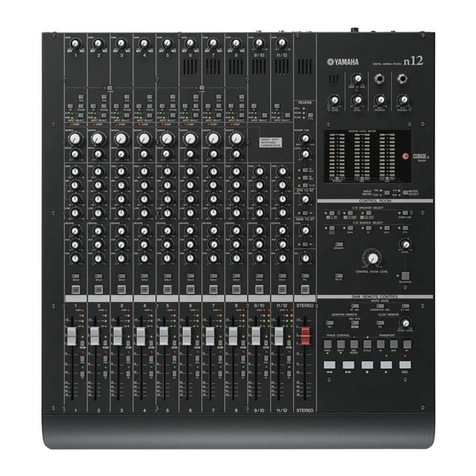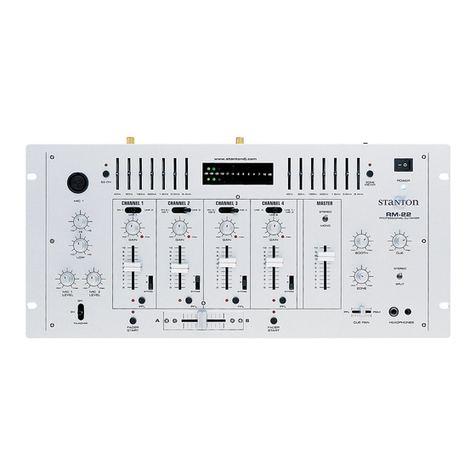Tieline i-Mix G3 TLM 600 User manual

TLM 600 Integrated Mixer-CODEC
Main Operation Manual
i-Mix G3 Reference Manual Version 11.0
Software Version: Tieline Toolbox V.4.13.20 RPTP version 99
Firmware Version: 1.6.00; RPTP version 99
October, 2007

Table of Contents
Tieline Page 2
T E C H N O L O G Y
Table of Contents
SECTION 1. SAFETY NOTICES AND WARNINGS...............................................13
SECTION 2. MANUAL CONVENTIONS.................................................................14
2.1. CONTROLS.........................................................................................................14
2.2. CONNECTOR PANEL...........................................................................................14
2.3. MENU TEXT........................................................................................................14
2.4. MENU NAVIGATION ...........................................................................................14
2.5. TOOLBOX SOFTWARE........................................................................................14
2.6. HYPERLINKS ......................................................................................................14
SECTION 3. WELCOME TO OUR REVOLUTION................................................16
SECTION 4. INTRODUCTION TO TIELINE CODECS.........................................18
4.1. FEATURES IN RELEASE VERSION 1.4.XX............................................................19
4.2. FEATURES IN RELEASE VERSION 1.6.XX............................................................20
4.3. FEATURES OF THE I-MIX G3..............................................................................22
4.4. DATA OPTIONS AVAILABLE...............................................................................23
4.5. COMPATIBILITY ACROSS THE G3RANGE OF CODECS ......................................24
SECTION 5. CODEC CONTROLS AND CONNECTIONS...................................25
SECTION 6. NEW CODEC MENU WIZARDS........................................................28
6.1. EASIER NAVIGATION..........................................................................................28
6.2. MODULE INDICATOR ARROWS...........................................................................29
6.3. CODEC MODULE OPTIONS................................................................................30
SECTION 7. QUICK START: CONNECTING QUICKLY USING MANUAL
DEFAULT PROFILES..........................................................................31
7.1. STEP 1:SET AUDIO CONFIGURATION SETTINGS...............................................32
7.2. STEP 2:SELECT A PROFILE................................................................................34
7.3. STEP 3:CHANGE CONNECTION SETTINGS........................................................36
7.4. GETTING CONNECTED.......................................................................................53
7.5. 10SIMPLE STEPS TO CONNECT TIELINE CODECS ............................................54
7.6. 3G/UMTSIP CONNECTIONS...........................................................................57
7.7. REMOTE CONTROL OF INPUT CONTROLS .........................................................59
7.8. CONFIGURING REMOTE CONTROL....................................................................60
7.9. ADJUSTING LOCAL (MASTER CODEC)AND REMOTE (SLAVE CODEC)INPUT
LEVELS WHEN IN REMOTE CONTROL CHANNEL MODE...................................61
7.10. USING THE MENU SELECTOR FOR REMOTE LEVEL CONTROL..........................61
7.11. RESET REMOTE CONTROL.................................................................................61
7.12. CODEC REMOTE CONTROL MENU STRUCTURE................................................62
SECTION 8. POTS OPERATION AND USAGE TIPS: HOW IT WORKS............63
8.1. HISTORICAL REFLECTIONS................................................................................63
8.2. MODEM NEGOTIATION AND LINE QUALITY FOR POTS MODE ........................64
8.3. POTSOPERATION PRECAUTIONS.....................................................................64
8.4. CALL WAITING...................................................................................................64
8.5. PRIVATE BRANCH EXCHANGES (PBX),PRIVATE AUTOMATIC BRANCH
EXCHANGES (PABX),BUSINESS SYSTEMS .......................................................65
8.6. LINE CHECKS.....................................................................................................65

Table of Contents
Tieline Page 3
T E C H N O L O G Y
8.7. EARTH LEAKAGE PROBLEMS ON THE LINE.......................................................66
8.8. EQUIPMENT PROBLEMS AT THE COOR LOCAL EXCHANGE.............................66
8.9. TIPS FOR SUCCESSFUL OPERATION ..................................................................67
8.10. POTSVERSUS NEW POTSG3 MODULES ........................................................68
8.11. STABILITY OF TIELINE POTS MODULES...........................................................69
8.12. SUMMARY:..........................................................................................................71
SECTION 9. ISDN.......................................................................................................73
9.1. IMPORTANT CONSIDERATIONS ..........................................................................73
9.2. WHAT ISDNMODULE DO INEED? ....................................................................73
9.3. HOW DO IINSTALL THE ISDNMODULE?..........................................................74
9.4. CONNECTING OVER ISDN.................................................................................75
SECTION 10. GSM...................................................................................................81
10.1. HOW DOES IT WORK?.........................................................................................81
10.2. HSCSDINFORMATION COURTESY OF GSMWORLD.COM ................................81
10.3. WHAT DO INEED FOR GSM?.............................................................................82
10.4. DEFAULT GSMCONNECTION SETTINGS ..........................................................82
10.5. CONFIGURING GSMCONNECTIONS USING A GSM MODULE .........................83
10.6. CONFIGURING GSMCONNECTIONS VIA THE RS 232SERIAL PORT................83
10.7. CONFIGURING A POTSLANDLINE CODEC FOR GSM CONNECTIONS.............85
10.8. MAKING GSM VOICE CALLS.............................................................................86
10.9. WHY MAKE GSMVOICE CALLS? ......................................................................86
10.10. SELECTING GSMVOICE MODE.....................................................................87
10.11. AFINAL NOTE ON GSMCONFIGURATION ...................................................89
SECTION 11. 3GIP...................................................................................................90
SECTION 12. SATELLITE.......................................................................................91
12.1. BROADBAND GLOBAL AREA NETWORK (BGAN).............................................91
SECTION 13. X.21....................................................................................................92
13.1. HOW DO X.21MODULES CONNECT TO THE NETWORK? ................................92
13.2. HOW DOES IT WORK?........................................................................................92
13.3. CONNECTING VIA X.21.....................................................................................93
SECTION 14. IP STREAMING CONFIGURATIONS...........................................94
SECTION 15. OPERATION OF YOUR CODEC: CODEC LCD DISPLAYS
AND DIALING CONNECTIONS....................................................95
15.1. GETTING STARTED:OPERATING THE MENU SELECTOR (MS)..........................95
15.2. CLEAR ................................................................................................................96
15.3. ADJUSTING INPUT LEVELS ................................................................................96
15.4. AUDIO MONITORING ON THE CODEC...............................................................96
15.5. ADJUSTING AUXILIARY AND PHONE INPUT LEVELS.........................................96
15.6. PRE-FLIGHT CONNECTION CHECKS..................................................................97
15.7. MENU NAVIGATION ...........................................................................................97
15.8. GETTING STARTED.............................................................................................98
15.9. THE LCDSCREEN ON INITIAL POWERUP..........................................................98
15.10. LOADING PROFILES.......................................................................................99
15.11. INITIAL CONNECTION STATE OF CODEC LCDDISPLAYS..........................100
15.12. INITIATING MANUAL CONNECTIONS:DIALING A NUMBER........................102
15.13. MANUAL ISDNCONNECTIONS.................................................................. 107

Table of Contents
Tieline Page 4
T E C H N O L O G Y
15.14. MANUAL GSMCONNECTIONS...................................................................108
15.15. MANUAL 3GCONNECTIONS ...................................................................... 109
15.16. MANUAL IPCONNECTIONS........................................................................110
15.17. MANUAL X.21CONNECTIONS ................................................................... 111
15.18. THE CONNECTIONS MANAGER (CXNS) .................................................... 112
15.19. SUMMARY:..................................................................................................114
15.20. MENU SETTINGS.........................................................................................115
15.21. MENU:SUBMENU DETAILS.........................................................................117
SECTION 16. DATA TRANSFER & USING 3RD PARTY DEVICES.................142
16.1. DATA OPTIONS AVAILABLE............................................................................142
16.2. THE SERIAL PORT DATA WIZARD................................................................... 142
16.3. AN INTRODUCTION TO SESSION DATA........................................................... 142
16.4. SOME BACKGROUND ON DATA PACKETS ...................................................... 142
16.5. THE OSIMODEL EXPLAINED.........................................................................143
16.6. THE SESSION LAYER.......................................................................................144
16.7. HOW TIELINE CODEC SESSION DATA WORKS...............................................144
16.8. CONFIGURING THE SERIAL PORT TO SEND DATA..........................................147
16.9. ENABLING SERIAL PORT DATA FLOW CONTROL...........................................147
16.10. GSMTRANSPARENT AND NON-TRANSPARENT DATA MODES................... 149
16.11. DTMFCONTROL OF 3RD PARTY DEVICES .................................................149
SECTION 17. RELAY AND CONTROL PORT OPERATION...........................151
17.1. EXTERNAL RELAY BOX................................................................................... 151
17.2. CABLING AND OPERATION DISTANCES.......................................................... 152
17.3. CANBUS CABLE TERMINATIONS .................................................................. 153
17.4. INPUTS ............................................................................................................153
17.5. OUTPUTS ........................................................................................................153
17.6. SETUP.............................................................................................................. 153
17.7. DIPSETTINGS................................................................................................. 154
17.8. CMOSRELAY OPERATIONAL MODE ............................................................. 154
17.9. FRONT PANEL LEDINDICATORS.................................................................... 154
17.10. PIEZO ALARM..............................................................................................154
SECTION 18. TOOLBOX OPERATION..............................................................155
18.1. TOOLBOX SOFTWARE DOWNLOADS ..............................................................155
18.2. PREPARING TO USE TOOLBOX SOFTWARE WITH YOUR CODEC ................... 156
18.3. CONNECTING YOUR CODEC TO A PC............................................................157
18.4. CONFIGURING TOOLBOX AND YOUR CODEC TO WORK TOGETHER ............ 157
18.5. CONNECTING TOOLBOX VIA USB.................................................................158
18.6. LANCONNECTION:STATIC,DHCPAND BOOTP IPADDRESSES............... 160
18.7. INSERTING STATIC IP ADDRESSES INTO A CODEC AND PC...........................160
18.8. SERIAL PORT CONNECTIONS:CONFIGURATION AT THE CODEC ITSELF........ 162
18.9. CONNECTING YOUR CODEC TO TOOLBOX SOFTWARE ..................................163
18.10. UPDATING FIRMWARE ................................................................................165
SECTION 19. CONFIGURATION FILE SYSTEM..............................................169
19.1. THE RELATIONSHIP BETWEEN CONFIGURATION FILES,PROFILES AND
MATRICES .......................................................................................................169
19.2. DIFFERENT CODEC CONFIGURATION FILES................................................... 170
19.3. SET,GET,SAVE AND OPEN FUNCTIONS OF CONFIGURATION FILES............. 171

Table of Contents
Tieline Page 5
T E C H N O L O G Y
SECTION 20. MATRIX EDITOR...........................................................................172
20.1. AN OVERVIEW.................................................................................................172
20.2. HOW DO IUSE MATRICES IN THE CODEC?..................................................... 172
20.3. ROUTING MATRICES EXPLAINED....................................................................173
20.4. ACTIVATING THE MATRIX EDITOR.................................................................. 174
20.5. MATRICES –WHERE DO ISTART? .................................................................. 175
20.6. DEFINING THE MATRIX EDITOR......................................................................176
20.7. CHECKING OF CROSS POINTS.........................................................................177
20.8. THE DEFAULT MATRICES:HOW TO USE THEM.............................................. 178
20.9. CREATING,SAVING AND AMENDING MATRICES.............................................180
20.10. ADDITIONAL EDIT MATRIX FUNCTIONS..................................................... 181
20.11. ALL MATRICES MENU FUNCTIONS............................................................. 181
SECTION 21. PROFILE EDITOR.........................................................................182
21.1. USER PROFILES...............................................................................................182
21.2. SET FACTORY DEFAULTS................................................................................183
21.3. MANUAL DEFAULT PROFILES:OVERVIEW......................................................183
21.4. SELECTING MANUAL DEFAULT PROFILES......................................................185
21.5. GENERAL ATTRIBUTES OF MANUAL DEFAULT PROFILES.............................. 185
21.6. CURRENT RUNTIME:OVERVIEW .....................................................................186
21.7. MANUAL DEFAULT PRESETS ..........................................................................186
21.8. MANUAL DEFAULT MONO PROGRAM............................................................187
21.9. MANUAL DEFAULT MONO/IFB.....................................................................188
21.10. MANUAL DEFAULT STEREO ....................................................................... 190
21.11. MANUAL DEFAULT DUAL PROGRAM.........................................................191
21.12. MANUAL DEFAULT BONDED MONO.......................................................... 191
21.13. CREATING A NEW PROFILE.........................................................................192
21.14. PROPERTIES................................................................................................192
21.15. HOW DO IUTILIZE PROFILE MASKS?........................................................193
21.16. COPY AND PASTE FUNCTIONS....................................................................193
21.17. DELETING A PROFILE.................................................................................. 194
21.18. RENAMING A PROFILE ................................................................................194
21.19. MAKING ADJUSTMENTS WITHIN PROFILES ................................................194
SECTION 22. CONNECTION SETUP.................................................................196
22.1. THE CONNECTION MANAGER.........................................................................196
22.2. CONNECTION NO............................................................................................197
22.3. BONDING:AN OVERVIEW ...............................................................................197
22.4. DIALING BONDED MONO CONNECTIONS ...................................................... 198
22.5. ISDN3BAND 4B BONDING (COMMANDER CODECS ONLY)........................199
22.6. CONFIGURING 4BCHANNEL CONNECTIONS (COMMANDER CODECS
ONLY)..............................................................................................................200
22.7. CONNECTION TYPE.........................................................................................201
22.8. CODING AND ALGORITHMS............................................................................ 205
22.9. MPEGEXPLAINED .........................................................................................207
22.10. TIELINE ALGORITHMS AVAILABLE .............................................................210
22.11. SAMPLERATE............................................................................................... 214
22.12. ALGORITHM CONNECTION MATRIX...........................................................214
22.13. PORTS AND CODEC CHANNELS:AN OVERVIEW.........................................217
22.14. PHONEBOOK NUMBERS .............................................................................219
22.15. AUTOMATIC REDIAL ...................................................................................220

Table of Contents
Tieline Page 6
T E C H N O L O G Y
22.16. FAILOVER PROFILE IN DETAIL....................................................................221
22.17. REMOTE PROFILE .......................................................................................228
22.18. ATYPICAL CONNECTION SETUP PROCEDURE...........................................228
SECTION 23. POTS TAB.......................................................................................229
23.1. POTSAND POTSG3 MODULE DIFFERENCES.............................................. 229
23.2. SELECT POTSINTERFACE..............................................................................230
23.3. OPERATING MODE..........................................................................................230
23.4. AUTO RENEGOTIATE:OVERVIEW....................................................................231
23.5. MODEM MAX BIT-RATE................................................................................... 231
23.6. MONITOR ENABLE .......................................................................................... 232
23.7. DETECT DIAL TONE........................................................................................232
23.8. DETECT PROGRESS TONE...............................................................................232
23.9. DISABLE LINE QUALITY.................................................................................. 232
23.10. QUICK NEGOTIATION ENABLE:OLD POTSMODULE ONLY .................... 232
23.11. DIAL METHOD............................................................................................ 233
23.12. LEASED LINE............................................................................................... 233
23.13. AUTO ANSWER............................................................................................ 233
23.14. DIAL PAUSE TIME.......................................................................................234
23.15. MANUAL DEFAULT ALGORITHM................................................................ 234
SECTION 24. GSM LL/GSM/USB-3G TAB.......................................................235
24.1. GSMCONNECTIONS....................................................................................... 236
24.2. 3GCONNECTIONS.......................................................................................... 236
24.3. SELECT GSMLANDLINE INTERFACE..............................................................236
24.4. OPERATING MODE..........................................................................................237
24.5. GSMLANDLINE PRE BUFFER SECS ............................................................... 237
24.6. GSMLANDLINE BITRATE............................................................................... 237
24.7. MANUAL DEFAULT GSMLANDLINE ALGORITHM.........................................238
24.8. GSM/USB-3GMODULE/CELLPHONE SETUP:SELECT GSMINTERFACE
(FOR A CODEC CONNECTING WITH A GSM CONNECTION).............................. 238
24.9. WIRELESS NETWORK TYPE............................................................................. 239
24.10. GSMPRE BUF SECS (FOR A CODEC CONNECTING WITH A GSM
CONNECTION)............................................................................................. 239
24.11. GSMBITRATE (FOR A CODEC CONNECTING WITH A GSMCONNECTION).240
24.12. MANUAL DEFAULT GSMALGORITHM (FOR A CODEC CONNECTING
WITH A GSMCONNECTION)....................................................................... 240
24.13. SIGNAL STRENGTH ENABLE AND RESET WAIT SECONDS.......................... 240
24.14. AFINAL NOTE ON GSMCONFIGURATION ................................................ 240
SECTION 25. ISDN TAB.......................................................................................241
25.1. SELECT ISDNINTERFACE............................................................................... 242
25.2. ISDNNETWORK TYPE....................................................................................242
25.3. ISDNLINE TYPE............................................................................................. 243
25.4. ISDNLOCAL SUBADDRESS............................................................................ 243
25.5. SPIDEXPLAINED............................................................................................ 243
25.6. SPID1,SPID2 (SERVICE PROFILE ID).......................................................... 244
25.7. DN1,DN2 AND MSNNUMBERS................................................................... 244
25.8. AUTO ANSWER ................................................................................................ 245
25.9. PHANTOM POWER DETECT.............................................................................245
25.10. MANUAL DEFAULT ALGORITHM................................................................ 245

Table of Contents
Tieline Page 7
T E C H N O L O G Y
25.11. SAMPLERATE............................................................................................... 245
SECTION 26. IP/LAN AND SIP TABS................................................................246
SECTION 27. X.21TAB..........................................................................................247
27.1. SELECT X.21INTERFACE................................................................................ 247
27.2. X.21LINK TYPE..............................................................................................247
27.3. BIT RATE......................................................................................................... 248
27.4. MANUAL DEFAULT ALGORITHM ....................................................................248
27.5. SAMPLE RATE .................................................................................................248
27.6. X.21CALL CONTROL TYPE............................................................................249
SECTION 28. INPUTS TAB ..................................................................................250
28.1. INPUT GAINS................................................................................................... 250
28.2. INPUT TYPES................................................................................................... 250
TABLE 12:INPUT GAIN SETTING OPTIONS................................................................. 251
28.3. ADDITIONAL INPUT SETTINGS........................................................................251
28.4. PHANTOM POWER........................................................................................... 252
28.5. INTELLIGENT GAIN CONTROL ........................................................................252
28.6. ROUTING VOICE CALLS TO A CODEC’S ANALOG OUTPUTS.......................... 253
28.7. PHONE INPUT:OPERATION OF THE I-MIX G3PHONE COUPLER .................. 253
28.8. AUXILIARY INPUT............................................................................................256
28.9. LOCAL AND REMOTE CODEC LEVEL ADJUSTMENT WITH TOOLBOX
SOFTWARE.......................................................................................................256
28.10. CONTROL MENU:ADJUSTING INPUT LEVELS USING TOOLBOX .............. 256
SECTION 29. REMOTE CONTROL TAB............................................................258
29.1. LOCAL AND REMOTE CODEC OPERATION EXPLAINED .................................. 258
29.2. REMOTE CONTROL OF INPUT GAINS.............................................................. 259
29.3. PROFILE REQUIREMENTS FOR REMOTE CONTROL.........................................260
29.4. CONFIGURING THE REMOTE (SLAVE)CODEC TO BE CONTROLLED............... 260
29.5. CONFIGURING THE LOCAL (MASTER)CODEC TO CONTROL THE REMOTE
CODEC ............................................................................................................261
29.6. ADJUSTING LOCAL (MASTER CODEC)AND REMOTE (SLAVE CODEC)INPUT
LEVELS WHEN IN REMOTE CONTROL CHANNEL MODE................................ 262
29.7. ACCEPT REMOTE CUE .................................................................................... 262
29.8. GANG TO KNOB.............................................................................................. 264
SECTION 30. OUTPUTS TAB..............................................................................265
30.1. PPMDISPLAYS...............................................................................................265
30.2. PACONTROLS................................................................................................ 267
30.3. AUTOMATIC GAIN CONTROL..........................................................................269
30.4. RELATIONSHIP OF IGCTO AGC....................................................................269
30.5. TALK BACK LEVEL ADJUSTMENT...................................................................270
SECTION 31. FUNCTIONS TAB..........................................................................271
31.1. CREATING A NEW USER FUNCTION................................................................272
31.2. ACTIVATION RULE ..........................................................................................273
31.3. SOME ACTIVATION RULE EXAMPLES..............................................................283
31.4. TASK RULE......................................................................................................284
31.5. PRESET USER FUNCTIONS.............................................................................. 298
31.6. EDIT FUNCTION ..............................................................................................303

Table of Contents
Tieline Page 8
T E C H N O L O G Y
31.7. DELETE FUNCTION .........................................................................................303
31.8. SOFTKEY MENU DISPLAY............................................................................... 303
31.9. AFINAL NOTE….............................................................................................. 304
SECTION 32. MATRIX MAP.................................................................................305
32.1. MATRIX MANAGEMENT –ATHREE STEP PROCESS....................................... 305
32.2. MATRIX MAPPING –AN OVERVIEW................................................................ 306
32.3. ‘MAPPING’MATRICES FOR CODEC FUNCTIONS.............................................307
32.4. CUE:AN OVERVIEW........................................................................................ 308
32.5. CUE/COMMS IN PREFADE OR OFF-LINE MONITORING MODE.......................309
32.6. CUE/COMMS AS ‘LOCAL’INTERCOM.............................................................309
32.7. USING CUE/COMMS AS ‘LOCAL’INTERCOM IN STEREO ...............................310
32.8. CUE AS CODEC-TO-CODEC INTERCOM............................................................ 310
32.9. TALKBACK....................................................................................................... 311
32.10. REMOTE CUE.............................................................................................. 312
32.11. PHONE AS TALKBACK.................................................................................313
32.12. CREATING PROFILES................................................................................... 313
SECTION 33. VIEW MATRIX................................................................................314
33.1. VIEW MATRIX MENU.......................................................................................314
33.2. AN EXAMPLE:INTEGRATED COMMUNICATIONS WITH A TIELINE
BROADCAST CODEC ....................................................................................... 315
SECTION 34. UNIT OPTIONS..............................................................................317
34.1. COUNTRY SELECTION..................................................................................... 317
34.2. POWERUP CONSOLE.......................................................................................317
34.3. AUTO RECONNECT..........................................................................................318
34.4. AUDIO REFERENCE LEVEL.............................................................................. 318
34.5. BONDING TYPE............................................................................................... 318
34.6. SESSION DATA ENABLE.................................................................................. 318
34.7. AUTO SOFTKEY ENABLE.................................................................................318
SECTION 35. GLOBAL UNIT SETTINGS ..........................................................319
35.1. UNIT LOCK......................................................................................................319
35.2. SPEED DIAL..................................................................................................... 319
35.3. POWERUP PROFILE......................................................................................... 320
35.4. POWERUP PROFILE:MANUAL DEFAULT PROFILE SETTINGS.........................320
35.5. SERIAL PORT MODE........................................................................................ 321
35.6. SERIAL PORT RATE......................................................................................... 321
35.7. SERIAL PORT FLOW CONTROL....................................................................... 321
SECTION 36. PHONEBOOK EDITOR................................................................322
36.1. NAME AND NUMBER....................................................................................... 323
36.2. INTERNATIONAL PREFIXES AND DIALING OUT OF A PBX..............................323
36.3. HOW DOES SPEED DIALING WORK?.............................................................. 323
36.4. PROGRAMMING PROFILES USING TOOLBOX.................................................325
36.5. STORING THE PHONEBOOK............................................................................326
SECTION 37. TROUBLESHOOTING TIPS........................................................328
37.1. POTSTROUBLESHOOTING............................................................................328
37.2. ISDNTROUBLESHOOTING............................................................................. 329
37.3. GSMTROUBLESHOOTING..............................................................................330

Table of Contents
Tieline Page 9
T E C H N O L O G Y
37.4. 3GTROUBLESHOOTING................................................................................. 330
37.5. IPTROUBLESHOOTING................................................................................... 330
37.6. X.21TROUBLESHOOTING .............................................................................. 331
SECTION 38. GLOSSARY.....................................................................................332
SECTION 39. PORTABLE POWERING SOLUTIONS......................................336
39.1. TIELINE BATTERY MODULE............................................................................336
39.2. THE 12VOLT VEHICLE POWER SUPPLY CABLE.............................................337
APPENDIX 1. CONNECTOR WIRING.................................................................338
APPENDIX 1.1. INTERCONNECTION OF RCAAND XLR CONNECTORS......................338
APPENDIX 1.2. RTSHEADPHONE CONNECTOR ........................................................339
APPENDIX 1.3. CODEC CONNECTION CABLE CONFIGURATIONS .............................. 339
APPENDIX 1.4. D9(RS232) DATA AND INTERFACE CONNECTORS..........................340
APPENDIX 1.5. D15X.21INTERFACE CONNECTOR ..................................................340
APPENDIX 1.6. X.21CONNECTIONS .......................................................................... 342
APPENDIX 1.7. XLR4PIN POWER CONNECTORS ..................................................... 343
APPENDIX 1.8. CMOSSOLID STATE RELAY CONNECTORS......................................343
APPENDIX 1.9. CMOSSOLID STATE RELAY SPECIFICATIONS .................................. 343
APPENDIX 1.10. CANCABLE WIRING CONFIGURATION......................................... 344
APPENDIX 2. SOFTWARE LICENSE...................................................................345
APPENDIX 3. WARRANTY ...................................................................................347
APPENDIX 4. COMPLIANCES.............................................................................348
APPENDIX 4.1. FCCPART 15 .................................................................................... 348
APPENDIX 4.2. FCCPART 68 .................................................................................... 348
APPENDIX 4.3. IC ....................................................................................................... 349
APPENDIX 4.4. CE&CETICK ................................................................................... 349
APPENDIX 5. CODEC SPECIFICATIONS...........................................................350
APPENDIX 6. CREDIT NOTICES.........................................................................351
INDEX...........................................................................................................................352

Table of Figures
Tieline Page 10
T E C H N O L O G Y
Table of Figures
FIGURE 1:I-MIX G3FRONT PANEL CONTROLS.............................................................................26
FIGURE 2:REAR PANEL DETAIL OF THE I-MIX G3REAR PANEL DETAIL OF THE TIELINE
I-MIX G3.................................................................................................................................27
FIGURE 3:POTSWIZARD MENU SCREEN.....................................................................................28
FIGURE 4:COMMANDER G3 MENU SCREEN MODULE INDICATOR ARROWS..............................29
FIGURE 5:I-MIX G3MENU SCREEN MODULE INDICATOR ARROWS............................................29
FIGURE 6:CODEC AUDIO MENU STRUCTURE...............................................................................33
FIGURE 7:POTSMENU WIZARD SCREEN DISPLAYING EDITING FUNCTIONALITY AVAILABLE.36
FIGURE 8:POTSMENU CONFIGURATION WIZARDS ....................................................................37
FIGURE 9:ISDNMENU CONFIGURATION WIZARD.......................................................................38
FIGURE 10:GSMMENU CONFIGURATION WIZARD .....................................................................39
FIGURE 11:IPMENU CONFIGURATION WIZARD...........................................................................40
FIGURE 12:3GWIZARD..................................................................................................................41
FIGURE 13:X.21MENU WIZARD ...................................................................................................42
FIGURE 14:X.21MPEG2LAYER 2RECOMMENDED BITRATES.................................................47
FIGURE 15:IPMPEG2LAYER 2RECOMMENDED BITRATES......................................................47
FIGURE 16:TYPICAL REMOTE CONTROL SETUP WITHOUT USING TOOLBOX............................59
FIGURE 17:REMOTE CONTROL CODEC MENUS...........................................................................62
FIGURE 18:ORIGINAL POTSMODULE .........................................................................................68
FIGURE 19:NEW POTSG3 MODULE............................................................................................69
FIGURE 20:NEW POTSG3 MODULE CONNECTING....................................................................70
FIGURE 21:STANDARD POTSCONNECTION SCREEN..................................................................70
FIGURE 22:TIELINE GSMMODULE AND ANTENNA.....................................................................81
FIGURE 23:PHONE AUDIO ROUTED TO ENCODER.......................................................................88
FIGURE 24:THE TIELINE PORTABLE SOLUTIONS RANGE............................................................89
FIGURE 25:X.21ISDNINTERFACE CONNECTION........................................................................93
FIGURE 26:PHONE/AUXILIARY INPUT LEVEL CONTROL LCDSCREEN.....................................97
FIGURE 27:NEW POTSG3 MODULE CONNECTING..................................................................104
FIGURE 28:STANDARD POTSCONNECTION SCREEN................................................................104
FIGURE 29:MENU SUBMENUS.....................................................................................................116
FIGURE 30:CONFIGURATION SUBMENU ITEMS..........................................................................119
FIGURE 31:SESSION DATA CHECK-BOX IN THE UNIT OPTIONS TAB........................................145
FIGURE 32:SESSION DATA STATUS DISPLAY.............................................................................146
FIGURE 33:DTMFCONTROL LCD SCREEN...............................................................................149
FIGURE 34:CONTROL PORTS ON A CODEC ................................................................................151
FIGURE 35:THE REAR VIEW OF A CAN 8+8EXTERNAL RELAY BOX........................................152
FIGURE 36:MAIN MENU SCREEN OF THE TOOLBOX PROGRAM ...............................................156
FIGURE 37:TOOLBOX RPTPERROR MESSAGE .........................................................................164
FIGURE 38:TOOLBOX INCOMPATIBILITY ERROR MESSAGE......................................................165
FIGURE 39:TOOLBOX SOFTWARE UPGRADE CONNECTION ERROR MESSAGE........................166
FIGURE 40:RPTPERROR MESSAGES..........................................................................................167
FIGURE 41:TOOLBOX UPGRADE WARNING...............................................................................167
FIGURE 42:ELEMENTS WITHIN A CONFIGURATION FILE............................................................170
FIGURE 43:INPUTS AND OUTPUTS OF THE ROUTING MATRIX..................................................173
FIGURE 44:MATRIX EDITOR MAIN MENU PAGE.........................................................................174
FIGURE 45:HOW TO CONFIGURE MATRICES..............................................................................176
FIGURE 46:TLM400PAFEED -PGM AND RETURN PGM MIX ..................................................179
FIGURE 47:THE PROFILE EDITOR MENU SCREEN FOR THE I-MIX G3 IN TOOLBOX
SOFTWARE............................................................................................................................182
FIGURE 48:THE SET FACTORY DEFAULTS DROP-DOWN MENU..................................................183
FIGURE 49:THE MANUAL DEFAULT PROGRAM B(MONO)MATRIX .........................................185
FIGURE 50:THE PROFILE ‘MASK’FOR MANUAL DEFAULT PRESETS ........................................186

Table of Figures
Tieline Page 11
T E C H N O L O G Y
FIGURE 51:MANUAL DEFAULT MONO PROGRAM MATRIX SETTINGS......................................187
FIGURE 52:MANUAL DEFAULT MONO/IFBMATRIX SETTINGS................................................188
FIGURE 53:MANUAL DEFAULT STEREO MATRIX SETTINGS......................................................190
FIGURE 54:MANUAL DEFAULT DUAL PROGRAM MATRIX SETTINGS .......................................191
FIGURE 55:THE ‘MASK’FOR MAN DFLT STEREO.......................................................................193
FIGURE 56:THE CONNECTION SETUP (ADVANCED)MENU IN THE PROFILE EDITOR .............196
FIGURE 57:LIST OF MANUAL DEFAULT PROFILES DISPLAYING CONNECTION TYPE
SETTING................................................................................................................................198
FIGURE 58:BONDING TYPE DROP-DOWN MENU........................................................................199
FIGURE 59:4BISDN PROFILE IN TOOLBOX..............................................................................200
FIGURE 60:PORT AND CODEC ASSIGNMENTS FOR STEREO USING 4B CHANNELS .................201
FIGURE 61:TIELINE GSMPLUG-IN MODULE..............................................................................202
FIGURE 62:SIMPLE FAILOVER USER FUNCTION.........................................................................223
FIGURE 63:FAILOVER CONNECTION DIALING AND PORT ALLOCATION PROGRAMMED
INTO A MAIN PROFILE..........................................................................................................225
FIGURE 64:FAILOVER PROFILE CONNECTION SETTINGS...........................................................226
FIGURE 65:MAIN PROFILE WITH REMOTE AND FAILOVER PROFILE SETTINGS........................226
FIGURE 66:THE POTSTAB PAGE IN THE PROFILE EDITOR......................................................229
FIGURE 67:GSMLL/GSM/USB-3GTAB IN TOOLBOX...........................................................235
FIGURE 68:THE ISDNMENU WITHIN TOOLBOX SOFTWARE.....................................................241
FIGURE 69:THE X.21TAB IN TOOLBOX SOFTWARE .................................................................247
FIGURE 70:THE INPUTS MENU IN TOOLBOX.............................................................................250
FIGURE 71:ROUTE PHONE INPUT TO OUTPUTS CHECK-BOX...................................................253
FIGURE 72:VIRTUAL INPUT FADERS IN A COMMANDER G3CODEC.........................................257
FIGURE 73:TOOLBOX REMOTE CONTROL MENU......................................................................258
FIGURE 74:TYPICAL REMOTE CONTROL SETUP WITHOUT USING TOOLBOX..........................259
FIGURE 75:ACTIVE CUE SOFTKEY FUNCTIONS ON THE COMMANDER G3FIELD UNIT ..........263
FIGURE 76:THE I-MIX G3OUTPUT MENU WITHIN THE PROFILE EDITOR IN TOOL BOX.........265
FIGURE 77:CODEC PPMMETERS ...............................................................................................266
FIGURE 78:DIAGRAM SHOWING CODEC HEADROOM................................................................266
FIGURE 79:THE LCDSCREEN OF THE COMMANDERG3FIELD UNIT .................................267
FIGURE 80:THE FUNCTIONS MENU WITHIN THE PROFILE EDITOR...........................................271
FIGURE 81:ADD/EDIT MENU IN THE FUNCTIONS MENU ..........................................................272
FIGURE 82:FUNCTIONS MENU -CATEGORY DROP-DOWN MENU .............................................273
FIGURE 83:THE DROP-DOWN MENU FOR SELECTING MATRICES...............................................307
FIGURE 84:THE CUE FUNCTION AS DISPLAYED ON A COMMANDER G3LCD........................308
FIGURE 85:THE MANUAL DEFAULT CUE/COMMS AUX MATRIX AS VIEWED IN VIEW
MATRIX.................................................................................................................................309
FIGURE 86:LOCAL INTERCOM USING MANUAL DEFAULT CUE/COMMS MATRICES...............309
FIGURE 87:INTER-CODEC INTERCOM USING THE MANUAL DEFAULT REM INTERCOM
MATRICES.............................................................................................................................310
FIGURE 88:TBTX AS VIEWED IN VIEW MATRIX WITHIN THE PROFILE EDITOR........................311
FIGURE 89:TBRX AS VIEWED IN VIEW MATRIX WITHIN THE PROFILE EDITOR .......................312
FIGURE 90:UNIT OPTIONS MENU IN TOOLBOX.........................................................................317
FIGURE 91:UNIT DETAILS MENU IN TOOLBOX..........................................................................319
FIGURE 92:THE PHONEBOOK EDITOR IN TOOLBOX.................................................................322
FIGURE 93:SPEED DIAL PROFILE AND NUMBER SCREEN..........................................................324
FIGURE 94:HANGUP &PROFILE CHANGE CONFIRMATION MESSAGE .....................................324
FIGURE 95:PHONEBOOK EDITOR IN TOOLBOX.........................................................................325
FIGURE 96:FEMALE D15INTERFACE CONNECTOR....................................................................341
FIGURE 97:MALE D15INTERFACE CONNECTOR .......................................................................341

Tables
Tieline Page 12
T E C H N O L O G Y
Tables
TABLE 1:UDP IPBROADBAND UPLINK BANDWIDTH TABLE...........................................44
TABLE 2:ISDNMPEG 2LAYER 2RECOMMENDED BITRATES.........................................46
TABLE 3:ALGORITHM CONNECTION BIT RATE TABLE......................................................48
TABLE 4:PROFILE,ALGORITHM AND SAMPLE RATE MATRIX ...........................................51
TABLE 5:DUAL MONO PROGRAM ALGORITHM MATRIX...................................................52
TABLE 6:ISDNMODULES .................................................................................................74
TABLE 7:THE OSI MODEL EXPLAINED ..........................................................................143
TABLE 8:CONFIGURATION FILE MENU OPTIONS........................................................... 171
TABLE 9:BONDING TYPE CODEC SETTINGS................................................................... 199
TABLE 10:ALGORITHM CONNECTION BIT RATE TABLE................................................. 215
TABLE 11:ISDNNETWORK SETTINGS ........................................................................... 243
TABLE 12:INPUT GAIN SETTING OPTIONS..................................................................... 251
TABLE 13:FUNCTIONS MENU -CATEGORY MENU.........................................................274
TABLE 14:FUNCTIONS MENU -SOURCE MENU.............................................................. 275
TABLE 15:KEY MENU.....................................................................................................276
TABLE 16:FUNCTIONS MENU -TRIGGER MENU.............................................................278
TABLE 17:FUNCTIONS MENU -TASK RULE CATEGORY MENU ..................................... 285
TABLE 18:FUNCTIONS MENU -TYPE MENU...................................................................287
TABLE 19:FUNCTIONS MENU -OBJECT AND OPERATION MENUS ................................ 289
TABLE 20:FUNCTIONS MENU –EXECUTABLE FUNCTION ON A REMOTE CODEC ......... 297
TABLE 21:ISDNCONNECTION CHECKLIST...................................................................329
TABLE 22:D9 DATA AND INTERFACE CONNECTOR ....................................................... 340
TABLE 23:X.21 PIN-OUTS FOR D-15CONNECTORS......................................................340
TABLE 24:XLR 4PIN POWER CONNECTOR...................................................................343

Section 1: Safety Notices and Warnings
Tieline Page 13
T E C H N O L O G Y
Section 1. Safety Notices and Warnings
SAFETY NOTICES and WARNINGS
THUNDERSTORMS and LIGHTNING
DO NOT USE Tieline codecs during thunderstorms and lightning.
You may suffer an injury using a phone, Tieline codec, or any device connected to
a phone during a thunderstorm
This can lead to personal injury and in extreme cases may be fatal.
Protective devices can be fitted to the line, however, due to the extremely high
voltages and energy levels involved in lightning strikes, these devices may not offer
protection to the users, the Tieline codec and equipment connected to the codec.
Secondary strikes can occur. These secondary strikes are induced by lightning
strikes and also produce dangerously high currents and energy levels. You only
need to be near an object struck by lightning to lead to personal injury or damage
to equipment. e.g. if located near a lighting tower at a sports facility, water features
and drains on golf courses you will be affected by these secondary strikes.
Damage to personnel and Tieline codecs may occur during thunderstorms, even if
the codec is turned off but is connected to the phone system or the power.
ANY DAMAGE TO A TIELINE PRODUCT CAUSED BY LIGHTNING or an
ELECTRICAL STORM WILL VOID THE WARRANTY.
WARNING: DIGITAL PHONE SYSTEMS
DO NOT CONNECT YOUR Tieline CODEC TO A DIGITAL PHONE SYSTEM.
PERMANENT DAMAGE MAY OCCUR!
If you are unfamiliar with any facility, check that the line you are using is NOT a
digital line. If the Tieline codec becomes faulty due to the use of a digital phone
system, the WARRANTY IS VOID.
(Related Topic: Tips for Successful Operation)
Disclaimer
Whilst every effort has been made to ensure the accuracy of this manual we are not
responsible for any errors or omissions within it. The product specifications and
descriptions within this manual will be subject to improvements and modifications
over time without notice, as changes to software and hardware are implemented.
PLEASE READ OUR SOFTWARE LICENSE BEFORE USING THIS PRODUCT.

Section 2: Manual Conventions
Tieline Page 14
T E C H N O L O G Y
Section 2. Manual Conventions
The conventions we have used in this manual are as follows:
2.1. Controls
Buttons, switches, and rotary controls are in ARIAL CAPITALS,the same font
and style as the labeling on the codec. E.g. SEND/RETURN refers to the
SEND/RETURN digipot.
2.2. Connector Panel
Labeling is done in Arial, reflecting the text on the codec. E.g. HEADPHONE 2 is
the socket for HEADPHONE 2.
2.3. Menu Text
Menu Text is done in boxed and is the exact text in the LCD window .
2.4. Menu Navigation
When describing how to navigate through detailed codec menus, the following
convention will be used. Bold Souvenir ITCTT for all characters; square brackets
to surround each individual menu item; inward facing arrows (inside the square
brackets, i.e. →Voice G3←) to indicate the menu setting; the > character is used
to indicate movement to the next menu item.
[Pots Wizard →Setup GSM Landline←] > [Algorithm →Voice G3←] > [GSM
Landline Rate →9600←] > [Pre-buffer Secs →0←] > [Auto Reconnect
→Disable←].
2.5. ToolBox Software
Any reference directly attributable to the ToolBox software will be in Souvenir
ITCTT Italic font. E.g.
Modem Max Bitrate.
If it appears in blue font color in
ToolBox software then it will appear in the same font but in blue. E.G.
Automatic
Redial
(in
Connection Setup
in the
Profile Editor
)
Any ToolBox software section tab or Main Menu title is in Souvenir ITCTT Bold
Italic font. E.g.
Profile Editor
2.6. Hyperlinks
If you are reading this document on a PC, within it there are many hyperlinks to
websites or to other related bookmarked elements within the manual. These are
characterized by being underlined as in the following example:
Connection Setup

Section 2: Manual Conventions
Tieline Page 15
T E C H N O L O G Y
If you are reading this document as a PDF simply click on the hyperlink to go to
the destination. If you are not viewing it as a PDF, to activate the hyperlink
place your mouse cursor on the hyperlink, hold down the Ctrl key on your
keyboard and click the left mouse button. This will take you to the hyperlink
destination.

Section 3: Welcome to our Revolution
Tieline Page 16
T E C H N O L O G Y
Section 3. Welcome to our Revolution
This may seem an outrageous statement, but Tieline has developed and currently
manufactures the world’s finest POTS, ISDN, GSM, X.21, 3G and IP codecs. You
will find that Tieline codecs have a whole range of invaluable features for creating low
cost, studio quality programs from remote locations. The Tieline codec family
includes:
i-Mix
G3
, the latest generation of 5 channel POTS, bonded POTS, ISDN,
GSM, IP and satellite ISDN mixer-codec, is justifiably known as the
‘sportscasters dream machine’.
COMMANDER
G3
, with two module slots, allows flexibility in the selection of
field POTS, ISDN, GSM and IP codec with full broadcast functionality.
COMMANDER
G3
1RU and 2RU rack unit codecs with similar features to
the field unit. A PC GUI (Graphical User Interface) can be connected to the
1RU codec, providing flexibility in controlling the codec and saving rack
space in the studio.
Tieline codec family specifications can be found at http://www.tieline.com
The Tieline i-Mix
G3
is an integrated 5 channel mixer and award winning studio
quality POTS, ISDN, GSM, 3G/IP, IP and X.21 codec. The superb Tieline DSP2
algorithm delivers crystal clear, studio quality bi-directional 15 kHz audio with an
insignificant 100ms delay. This single unit weights only 5lb (2kg) and is easily placed
in a briefcase and transported as carry-on baggage, allowing timely and convenient
worldwide deployment of presenters without technical staff. With headsets you have a
complete remote broadcast facility.
The i-Mix
G3
concept is about combining suitable communications and
programming modules together to create the right portable studio for your remote
broadcast. Tieline’s most recent technological advances combine IP, 3G/IP cell-
phone, SIP and X.21 functionality into the i-Mix
G3
.
The superb Tieline
Music
and
Music Plus
algorithms deliver crystal clear, studio
quality bi-directional FM quality audio with low delay. This single unit weights only
5lb (2kg) and is easily placed in a briefcase and transported as carry-on baggage,
allowing timely and convenient worldwide deployment of presenters without
technical staff. With headsets you have a complete remote broadcast facility.
There are a multitude of connection possibilities to suit every broadcast situation.
You can use two POTS connections for stereo or dual-mono POTS. Dual-mono
POTS allows programming to be sent to more than one destination from the same
POTS codec.
One of the unique features of the i-Mix
G3
is the ability to connect via a bonded
POTS connection. For example, if you have two POTS connections that are each
achieving bitrates of 12,000 bps, you can bond these connections to create a single
24,000 bps connection.

Section 3: Welcome to our Revolution
Tieline Page 17
T E C H N O L O G Y
For the first time broadcasters are able to phase lock left and right audio channels
over two ordinary telephone lines to deliver stable and reliable 15kHz FM quality
stereo programming – all for the cost of a couple of regular telephone calls. In some
parts of the world, local telephone calls are free which could allow some FM
broadcasters a studio to transmitter link with no transmission costs at all!
Combine an ISDN module with a 15 kHz POTS connection to provide IFB over
POTS and program over ISDN. Using IP and 3GIP you can connect codecs over
wireless 3G networks or connect over a private Local Area Network (LAN), or over
different public networks such as the Internet. Tieline codecs can supply high
bandwidth audio and communications data over national and international
networks. Integration of X.21 capabilities into Tieline codecs adds even more
flexibility in connecting across leased line networks.
The Tieline i-Mix
G3
is designed to be operated in conjunction with ToolBox PC
software. Most functions can be programmed via the codec itself, but to get the most
out of your codec you can program it using ToolBox software.
One of the features of the Tieline i-Mix
G3
platform is the Configuration File
System. It enables a user to configure the codec with ToolBox software before
arriving at a remote broadcast site, minimizing the amount of adjustments a
broadcaster has to make when arriving at a remote site.
Tieline’s Connection Manager automates the process of making a connection with
the i-Mix
G3
from a remote site. All a user has to do is turn the codec on, wait for
the menu on the LCD screen to light up and then select START.Even dialing
manually with the i-Mix
G3
is simple. Connect to a preferred dialing interface and
dial the number of a remote codec. The remote Tieline codec automatically answers
the call and establishes a secure link at the best quality the line will allow.
Tieline’s unique remote control feature allows the setting and continuous supervision
of all switch settings and audio levels remotely from a codec. This can be done either
from a studio or a laptop PC connected to a codec – leaving an announcer free to
concentrate on the content of a broadcast, not the technical parameters.
In summary, Tieline codecs provide opportunities previously impossible to engineer,
or simply too expensive to contemplate. The Tieline i-Mix
G3
is the perfect
solution for remote broadcasters. In the audio broadcast revolution - hearing is
believing… welcome to our revolution!

Section 4: Introduction to the Codec
Tieline Page 18
T E C H N O L O G Y
Section 4. Introduction to Tieline Codecs
If you are a new user or even if you are very familiar with a previous model of Tieline
codec, we highly recommend that you at least familiarize yourself with a few of the
sections within this manual. These sections include:
Connecting Your Codec to a PC;
Quick Start: Connecting Quickly Using Manual Default Profiles;
Operation of your Codec; and
Configuration File System.
The ‘Connecting Your Codec to a PC’ section of this manual will describe how to
configure your codec and ToolBox software, so that they will communicate effectively
with each other.
The section called ‘Configuration File System’ will give you a good understanding of
how Configuration Files are used to store profiles and how to program them into a
codec. If you need further information on these areas the ‘Matrix Editor’ and ‘Profile
Editor’ sections will explain this in more detail.
The ‘Operation of your Codec’ section will assist the experienced user to use the
codec with a minimum of fuss - without using ToolBox software. It includes an
explanation of the basic operations required to connect and adjust audio input levels
etc. You will of course need to use ToolBox software for many codec operations.
This includes creating and amending matrices for profiles and saving configuration
files.
The ‘Quick Start: Connecting Quickly Using Manual Default Profiles’ section of the
manual gives a really quick explanation of how to connect your codecs by using
manual default profiles that come with the codec.
Have fun with your new codec. It is at the leading edge of codec technology and will
deliver superior performance for you and your broadcast partners.
Help us to help you: We value feedback from our customers and encourage you to
help us make your job easier by emailing any suggestions on how we can improve

Section 4: Introduction to the Codec
Tieline Page 19
T E C H N O L O G Y
4.1. Features in Release Version 1.4.xx
Following is an overview of the new features incorporated into Tieline Firmware
Release 1.4.
It is no longer necessary to select the
ManDflt Bonded Mono
profile for
bonded connections - this profile has been removed. Simply select
ManDflt MonoPgm
and if a second connection is dialed it will
automatically be bonded;
3G has been updated to provide 3G to 3G call functionality;
Tieline broadcast codecs now support ISDN 3B and 4B bonding
(COMMANDER
G3
only) in order to create connections of up to 256
kbps in bandwidth;
It is now possible to make voice calls using V.1.2 POTS plug-in modules;
It is now possible to make voice calls over GSM plug-in modules or cell-
phones;
The
Phonebook Editor
now supports speed dialing numbers and
associated profiles (both manual default and custom created profiles);
Phonebook Editor
capacity has increased from 50 numbers to 80;
It is now possible to connect using the
MP2
algorithm and simultaneously
connect via
RS232
(between Tieline broadcast codecs only) to send data
or use ToolBox;
AGC (Automatic Gain Control) is visible in codec menus and able to be
switched on and off if required;
Aux/Phone input level can be adjusted via the codec Audio menu by
pressing Softkey 1;
Updates to session data include the ability to turn it on and off in codecs
and view if it is operating properly via codec menus;
The phone input can be routed to the codec analog outputs via the Audio
menu by pressing Softkey 1 (i-Mix only);
AES/EBU functionality is fully integrated (COMMANDER
G3
rack unit
only); and
X.21/V.35 functionality is fully integrated.

Section 4: Introduction to the Codec
Tieline Page 20
T E C H N O L O G Y
4.2. Features in Release Version 1.6.xx
Numerous changes have occurred in release 1.6.xx. Most of these relate to IP
and 3G IP connections. As a result, these sections have been extracted from all
codec reference manuals and have been amalgamated into a manual titled the
“IP & 3GIP Streaming Reference Manual”.
This manual contains all the latest connection information relating to IP and
3GIP in general. It also contains information about SIP connectivity and updated
quick start guides for studio and field unit codecs, as well as for wireless 3G
networks.
Following is a summary of the new and updated features that are contained in
the “IP & 3GIP Streaming Reference Manual”.
Updates to how to connect a codec for IP in a studio using a static IP
address;
Updates to how to connect a codec for IP in the field using DHCP
addresses;
Updates to how to connect a codec over 3GIP using new codec menus;
3G Modules available for GSM, GSM Voice, UMTS, EVDO and HSDPA
connections;
Codec interoperability using SIP;
Addition of the high quality, low delay
Music Plus
algorithm;
Support for IP dial/answer without using session data;
Permanent display of signal strength using 3G modules;
Information about how using v.1.6.xx software guarantees the ability to
use auto jitter buffer over IP/3GIP networks;
•Also how if dialing to a lower software version than v.1.6.xx
jitter buffer defaults to the default fixed setting of 500ms.
Jitter buffer software changes;
•New Auto Jitter Buffer use;
•5 new settings for auto jitter buffer;
•4 stages to jitter buffer when dialing and connecting;
•Auto jitter buffer and how it works adaptively with FEC by
measuring FEC on a connection and adjusting the jitter buffer
appropriately to suit;
Full explanation of the "Connection Details" screen and the elements
within it, including:
•How to use the new "Loss; Empty; Late; FECd" indications in
the "Connection Details" LCD screen to determine the
reliability and optimum IP jitter buffer and FEC settings;
How to order the right 3G data plan;
3G Antennae: how and what to select for the module purchased, i.e. EV-
DO versus UMTS/HSDPA
USB module use:
This manual suits for next models
1
Table of contents
